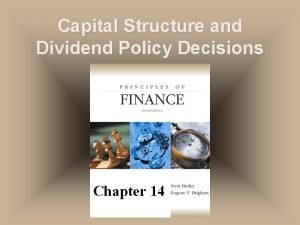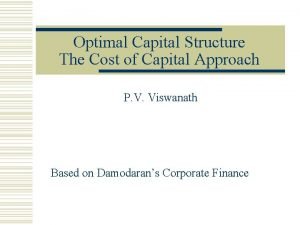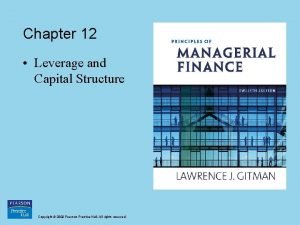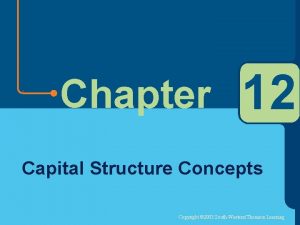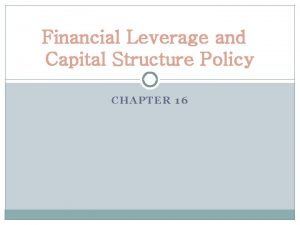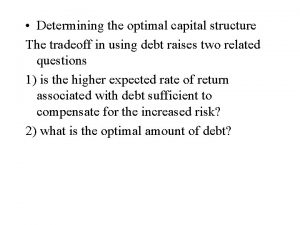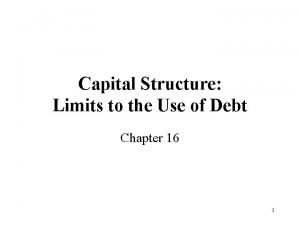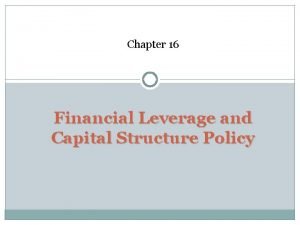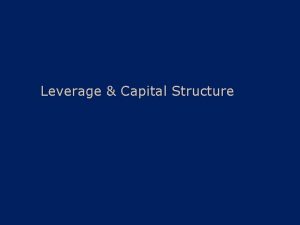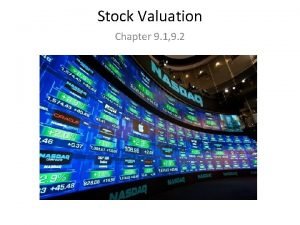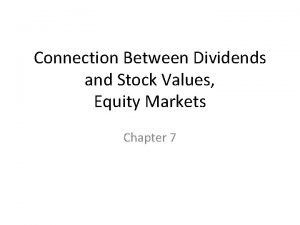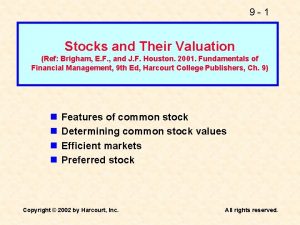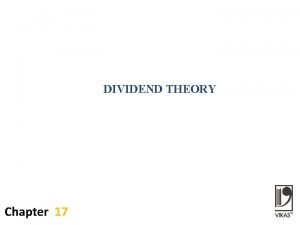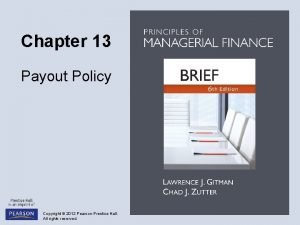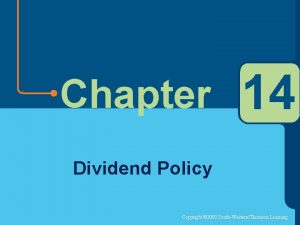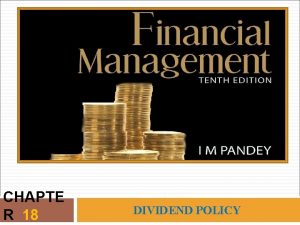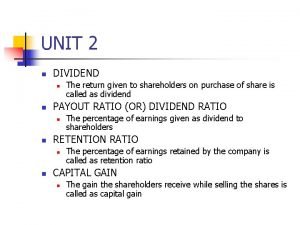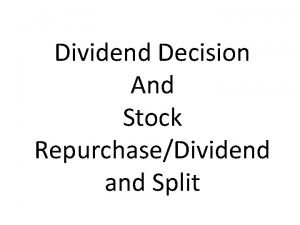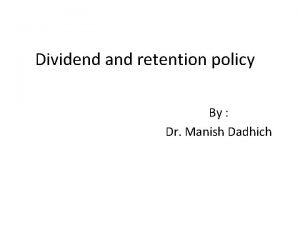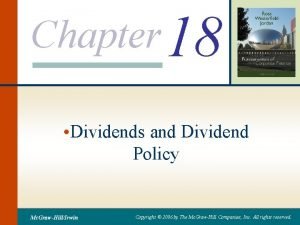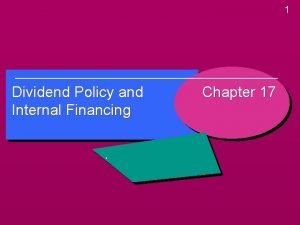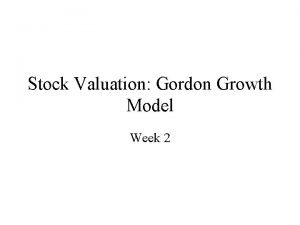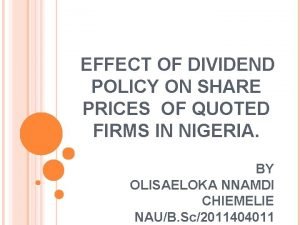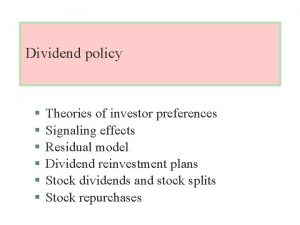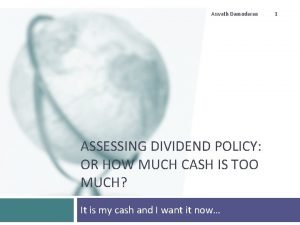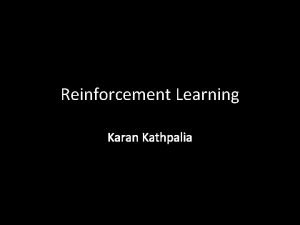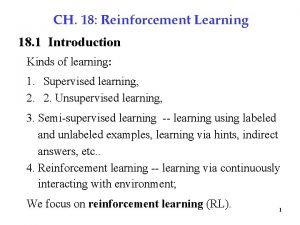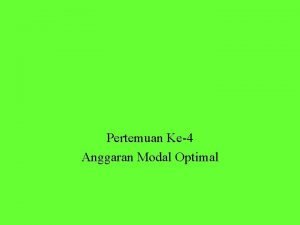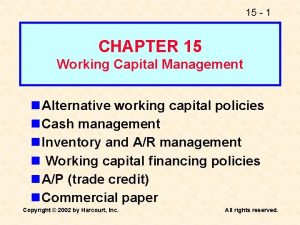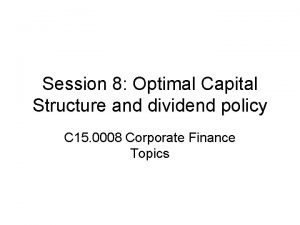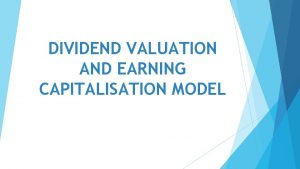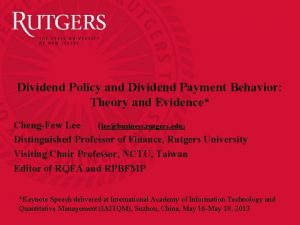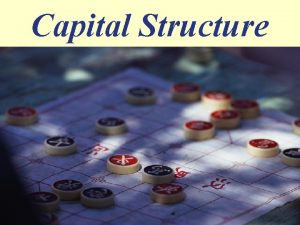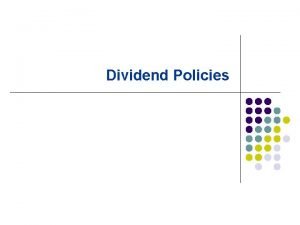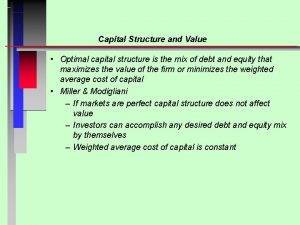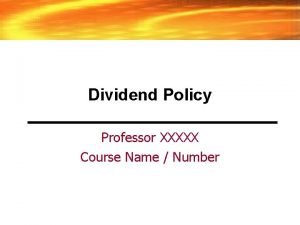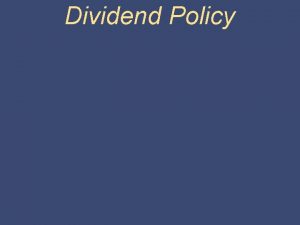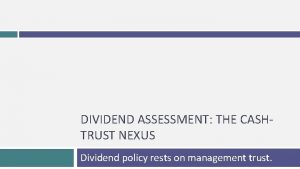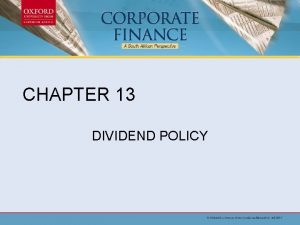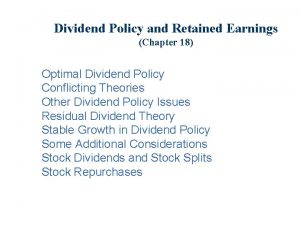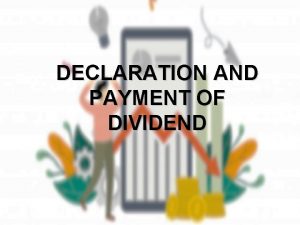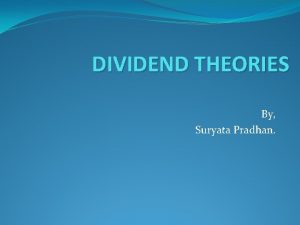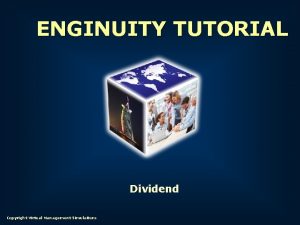Session 8 Optimal Capital Structure and dividend policy







































- Slides: 39

Session 8: Optimal Capital Structure and dividend policy C 15. 0008 Corporate Finance Topics

Optimal Capital Structure Review • The main theory we consider is the tradeoff theory. • Debt gives you a tax-shield. Hence more debt is GOOD. • Debt increases probability of distress. This increases expected distress costs, and agency costs. Hence more debt is BAD • At some level of debt, the two balance out. That is the optimal level of debt

WACC approach V = UCFt/(1+r. WACC)t UCF = EBIT(1 -T) + depreciation – capex – nwc • Calculate WACC at various debt levels – r. B from debt rating via interest coverage and leverage ratios – r. S from Prop. II r. S = r 0 + (1 - TC)(B/S)(r 0 - r. B) – WACC = (B/(S+B)) r. B(1 -T)+(S/(S+B)) r. S • Adjust expected cash flows for financial distress costs

At the level of betas CAPM: r 0 = r. F + U(r. M - r. F) (unlevered equity) r. S = r. F + L(r. M - r. F) (levered equity) r. B = r. F + B(r. M - r. F) (firm’s debt) Prop. II: r. S = r 0 + (1 - TC)(B/S)(r 0 - r. B) r. S = r. F + U(r. M - r. F) + (1 - TC)(B/S)( U- B)(r. M - r. F) = r. F + [ U + (1 - TC)(B/S)( U- B)](r. M - r. F) L = U + (1 - TC)(B/S)( U- B) (If debt is riskless, B =0) L = [1+ (1 - TC)(B/S) ] U

Worksheet. .

APV approach VL = VU + PV(tax shield) - PV(financial distress costs) • PV(tax shield) = t [TC(interest expense)t] / (1+ r. B)t – The expected tax rate decreases as debt increases. Use likelihood of distress. • PV(financial distress costs) = Prob * PV (financial distress costs if financial distress takes place) – The probability increases as the debt rating declines – Cost are usually estimated as a percentage of predistress firm value (~10 -20%)

Worksheet

Binomial Tree Firm: • Single remaining cash flow in 1 year EBIT $10 million or $2 million (prob. 50%) no salvage value • Corporate tax rate: T=40% • Unlevered required return: r 0=10% • In the event of bankruptcy – Financial distress costs are 15% of VU – Pay taxes, financial distress costs, residual goes to bondholders

The Unlevered Firm VU = S Liquidating dividend is only cash flow Value via DCF EBIT(1 -T)=10(1 -0. 4)=6 [0. 5(6)+0. 5(1. 2)]/1. 1=3. 27 EBIT(1 -T)=2(1 -0. 4)=1. 2

The Levered Firm • $2 million amount of (risky) 1 -year debt • Promised interest rate = 56. 65% (rf=2%) • Promised payment (at maturity) 2(1+56. 65%)=3. 13 – Solvent for high EBIT Payment to bondholders: 3. 13 – Bankrupt for low EBIT Payment to bondholders: EBIT-taxes-financial distress costs = EBIT-(EBIT-int. exp. )T-0. 15 VU = 2 -[2 -2(56. 65%)]0. 4 -0. 15(3. 27) = 1. 16

Debt Value Replicate using the unlevered firm (rf=2%) 6 3. 27 3. 13 B 1. 2 1. 16 H=0. 41, B*=-0. 656, B=2 (trading at par!!)

Equity Value Replicate using the unlevered firm (rf=2%) 6 3. 27 1. 2 (EBIT-56. 65%(B))(1 -T)-B=3. 32 S 0 H=0. 69, B*=0. 814, S=1. 45 r. S=14. 49%

Firm Value VU = S = 3. 27 VL = S + B = 1. 45 + 2 =3. 45 VL = VU + PV(tax shield) - PV(f. d. costs) ? In this case, the tax shield is risk-less (even though the debt is risky): PV(tax shield) = [56. 65%(2)(0. 4)/1. 02] = 0. 444

Financial Distress Costs Replicate using the unlevered firm (rf=2%) 6 3. 27 0 FD 1. 2 0. 491 H = -0. 102, B* = -0. 602, FD = 0. 267 VL = VU + PV(tax shield) - PV(f. d. costs) = 3. 27 + 0. 444 - 0. 267 = 3. 45

Optimal Capital Structure The optimal amount of debt • Decreases as business risk increases (distress costs) • Decreases as in tangible assets increase (distress costs) • Increases as the corporate tax rate increases (tax shields) • Decreases as the growth rate increases (growing firms are riskier. Hence distress costs) This slide is important!!!

Industry Data Industry Debt Ratio EBITDA/ Value Fixed Assets/ Capital Biotech 3. 78% 2. 63% 15. 33% Food 22. 85% 12. 60% Wholesaler s 59. 54% Electric Utility 89. 22% 58. 07% 16. 58% Source: http: //www. stern. nyu. edu/~adamodar/

Empirical Evidence • Consistent with much of theory (e. g. , over time, across industries, across tax regimes) • Profitable companies within industries appear underlevered (pecking order theory) • Leverage increasing (decreasing) transactions have positive (negative) effects on stock prices • Too many high-rated companies? • Financial flexibility—another real option? • Targeting a debt rating?

Capital Structure in Practice What do CFOs look at in determining debt policy? Financial flexibility Debt rating Volatility Tax savings 59% 57% 48% 45% Most firms (81%) have at least a flexible target debt-equity ratio. Source: http: //www. stern. nyu. edu/~adamodar/

Dividend Policy • Dividend policy: theory and evidence • Dividend decisions in practice • Stock dividends, splits, and repurchases

Two Questions • How much of earnings should the firm retain as cash? – Liquidity – Fund future projects/acquisitions without going to the capital markets – Reserve for future debt payments • How should the residual be paid out? – Dividends – Stock repurchases

A More Refined Question Let’s assume that • Investment decisions (projects) are fixed • Financing decisions (capital structure) are fixed Does dividend policy affect stock price? Does dividend policy affect firm value? The dividend decision is a tradeoff between paying dividends, issuing equity, and repurchasing stock.

An Example A firm generates a cash-flow of $1 million. It needs $500 K for investment. Three alternatives: (1) Invest $500 K, pay $500 K dividends (2) Invest $500 K, pay $1 million dividends, raise $500 K new equity (3) Invest $500 K, pay $0 dividends, repurchase $500 K of stock

Three Views of Dividend Policy (1) Dividend policy is irrelevant (2) High dividends are good (3) Low dividends are good “Good” here means higher stock price, which means • Higher cash flows • Lower cost of equity ( r. S = D/P + g )

Dividend Irrelevance Miller/Modigliani: in perfect markets, investors can create their own dividends, therefore dividend policy is irrelevant • Do-it-yourself dividends = stock sales • Undo-it-yourself dividends = stock purchases with the money from dividend income

Example of Dividend Irrelevance • Two dividend payment dates: 0, 1 • Investor prefers cash-flows of 10 and 10 each • Company decides to pay 11 and 8. 9. Cost of equity is 10% • Investor can choose to keep 10 and invest 1 in the company’s shares. • Investment of 1 gives an expected cash flow of 1. 1 • 8. 9 + 1. 1 = 10. Thus investor can recreate her preferred cash-flow

Some reasons why dividends matter If Managers misuse free cash flow Transaction costs high Issuance costs Then High dividends are good are High/Low dividends are good Personal Taxes Low dividends Clientele effects High/low dividends

Information Effects • Unexpected changes in dividends cause stock price reactions: D P • Why? Because dividends convey news about future earnings.

Empirical Evidence • Not conclusive • Survey data suggest managers think dividend policy is important • Tax changes appear to trigger dividend policy changes • Non-payers tend to initiate dividends when the spread between the M/B ratios of payers and non-payers is high

Stock Repurchases • • Signal that stock is under-valued Increase debt-equity ratio Eliminate certain stockholders (targeted) Tax benefits Stock price reaction is positive!

Disappearing Dividends

Disappearing Dividends cont’d Reasons: SEC Rule 10 b-18, Executive compensation through stock options

Conclusions • Issuance costs of new equity matter, dividend policy should be responsive to investment opportunities • Taxes, transaction costs, and agency costs play a role • Information effects are important (an explicit policy is valuable)

Practical Considerations • • • Restrictions, e. g. , bond covenants Liquidity Access to capital markets Earnings predictability Ownership

Types of dividend policies • Constant payout ratio • Constant dollar dividend • Small regular dividend plus special dividends • Target payout ratio, slow adjustment, stepwise progression

GE’s Dividend

Payment Procedure • Declaration date -- dividend announced • Ex-day -- stock first trades without right to dividend • Payment date -- checks mailed Declaration Ex-day Payment

Exam points • Recapitalizations • Unlevering a levered firm to find return on unlevered equity • Relevering an unlevered firm at a target ratio, WACC formula • APV: Computing tax shields, default probability, Cost of distress • Valuing distress costs like options

Exam points • • Dividend irrelevance Factors that affect dividend policy Tax effects Information effects

Assignments • • • Chapter 17 Problems 17. 2, 17. 5, 17. 11 Problem set 2 due Wednesday Case USG due Monday, Jul 31 Start preparing for the exam
 Dividend policy and capital structure
Dividend policy and capital structure Damodaran optimal capital structure
Damodaran optimal capital structure Optimal capital structure formula
Optimal capital structure formula How to calculate optimal capital structure
How to calculate optimal capital structure Static theory of capital structure
Static theory of capital structure Determining optimal capital structure
Determining optimal capital structure Optimal capital structure
Optimal capital structure Financial leverage and capital structure policy
Financial leverage and capital structure policy Financial leverage and capital structure policy
Financial leverage and capital structure policy Multinational cost of capital and capital structure
Multinational cost of capital and capital structure Multinational cost of capital and capital structure
Multinational cost of capital and capital structure Dividend yield and capital gains yield
Dividend yield and capital gains yield Dividend yield and capital gains yield
Dividend yield and capital gains yield Dividend yield and capital gains yield
Dividend yield and capital gains yield Dividend theory
Dividend theory Ex dividend record date
Ex dividend record date Factors affecting dividend policy
Factors affecting dividend policy Types of dividend policy
Types of dividend policy The residual theory of dividend policy asserts that
The residual theory of dividend policy asserts that Objectives of dividend policy
Objectives of dividend policy In walter, model of dividend policy formula d stands for
In walter, model of dividend policy formula d stands for Dividend ex date
Dividend ex date Walter formula for dividend policy
Walter formula for dividend policy The information content of dividends refers to
The information content of dividends refers to Compromise dividend policy
Compromise dividend policy Constant dollar dividend policy
Constant dollar dividend policy Gordon growth model
Gordon growth model Dividend policy decision in financial management
Dividend policy decision in financial management Gordon model of dividend policy
Gordon model of dividend policy Dividend policy decision in financial management
Dividend policy decision in financial management Residual dividend policy advantages disadvantages
Residual dividend policy advantages disadvantages Vale dividend policy
Vale dividend policy Karan kathpalia
Karan kathpalia What is optimal policy in reinforcement learning
What is optimal policy in reinforcement learning Apa itu penganggaran modal
Apa itu penganggaran modal What is gross working capital
What is gross working capital Source of capital reserve
Source of capital reserve Difference between capital reserve and reserve capital
Difference between capital reserve and reserve capital Variable capital examples
Variable capital examples Working capital financing policy
Working capital financing policy
